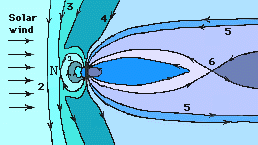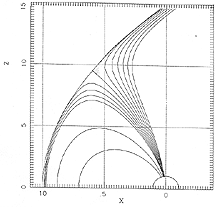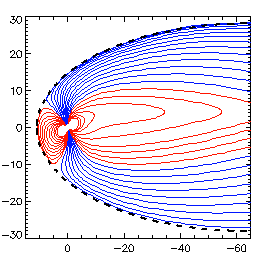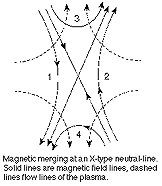In 1961 James Dungey in England proposed that when this happened, a neutral point N (or a more extended "neutral line") formed somewhere near the nose, and as plasma flowed through it, field line connections became realigned. Terrestrial lines like the one numbered "2" in the drawing, and interplanetary ones like the outer one also numbered "2", would each be "opened up" and reconnected, so that the ions strung out along each line "like beads on a string" became divided into two groups, one group flowing north, the other flowing south.
 The northward flowing group would migrate to line "3" in the drawing, an "open magnetic field line" linking Earth to interplanetary space. A short time later the field line linking those particles will occupy position "4", then "5". Dungey proposed that the process was reversed at some distant neutral point (or neutral line) "6" in the far tail, as illustrated here by a figure adapted from his original article. There the interplanetary line halves were reunited and flowed away, and the ends connected to Earth were also joined up again.
The northward flowing group would migrate to line "3" in the drawing, an "open magnetic field line" linking Earth to interplanetary space. A short time later the field line linking those particles will occupy position "4", then "5". Dungey proposed that the process was reversed at some distant neutral point (or neutral line) "6" in the far tail, as illustrated here by a figure adapted from his original article. There the interplanetary line halves were reunited and flowed away, and the ends connected to Earth were also joined up again.
Since the nose of the magnetosphere (on the average) maintains its position and is not "worn away" by the reconnection process, the magnetic field lines swept into the tail, and the plasma particles strung along them, must somehow flow back towards Earth, inside the magnetosphere. This (according to Dungey) explained the large-scale sunward flow of the tail, deduced from auroral motions and flows in the polar ionsphere, on field lines which extended into the tail.
Dungey's process of "magnetic reconnection" is expected to increase the flow of energy from the solar wind to the magnetosphere, by establishing a direct field-line link between the two. It does, however, require a southward slant of interplanetary magnetic field lines, a condition which only exists about half the time.
In 1966, soon after regular observations of the IMF began, a student of Dungey, Don Fairfield, did in fact note a strong correlation between such southward slants and the storminess of the magnetic field ("magnetic activity"). Nowadays "southward IMF" is recognized as the most important factor promoting storms and substorms in the magnetosphere, far more important than increased velocity or pressure of the solar wind, sunspot numbers, etc. This connection supports Dungey's idea of an "open magnetosphere," though direct evidence by observing interconnecting field lines is rather hard to obtain.
Reconnection with a Northward IMF?
In the figure of the Earth's northern cusp shown here, all magnetic field lines ultimately head into the north polar region of Earth. It follows that near the magnetopause, field lines located equatorward of the cusp are slanted northward and point away from the Sun, while lines tailward of the cusp slant southward and point towards the Sun. If magnetic reconnection requires oppositely directed field lines, this may suggest not only that when IMF lines slant southward, they reconnect to terrestrial field lines near the "nose" of the magnetosphere (as Dungey proposed), but also that when the IMF slants northward, they might reconnect poleward of the cusp, as proposed by Maezawa in Japan. It is an odd type of reconnection, affecting mainly the far tail, whose structure is still not completely clear.

Added 2000: Currently the "Polar" spacecraft is orbiting in an elongated orbit rising above the northern polar cap to distances of up to 9 RE. The magnetopause is usually further away, but at times of high solar wind pressure, "Polar" has found itself in the cusp region and even outside the magnetopause. On May 29, 1996, this happened during a time of strong northward IMF, and features were observed which might have originated in this strange sort of reconnection.
Questions from Users:
***



 The northward flowing group would migrate to line "3" in the drawing, an "open magnetic field line" linking Earth to interplanetary space. A short time later the field line linking those particles will occupy position "4", then "5". Dungey proposed that the process was reversed at some distant neutral point (or neutral line) "6" in the far tail, as illustrated here by a figure adapted from his original article. There the interplanetary line halves were reunited and flowed away, and the ends connected to Earth were also joined up again.
The northward flowing group would migrate to line "3" in the drawing, an "open magnetic field line" linking Earth to interplanetary space. A short time later the field line linking those particles will occupy position "4", then "5". Dungey proposed that the process was reversed at some distant neutral point (or neutral line) "6" in the far tail, as illustrated here by a figure adapted from his original article. There the interplanetary line halves were reunited and flowed away, and the ends connected to Earth were also joined up again.